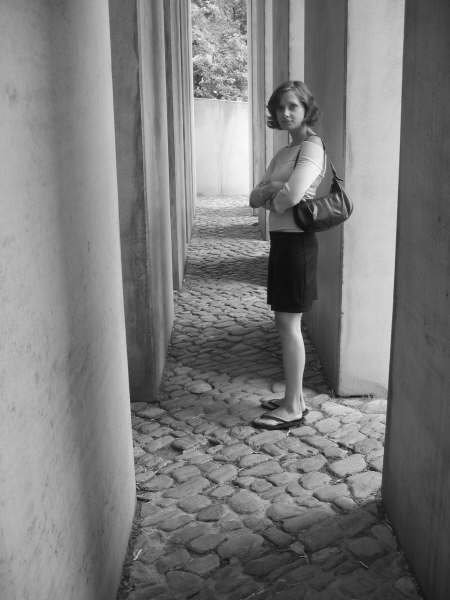 I've had human rights on my brain lately. I re-read Michael Ignatieff's The Rights Revolution at the end of August, and I must admit that its themes have coloured much of what I have read, written, thought about and discussed since. My loved ones have been very patient with me when I've turned our conversations to the topic of rights. Intrigued by the ambitious Canadian Museum for Human Rights project, I even reflected on individual and group rights and responsibilities in Canada at my thesis defense (despite the fact that my research had nothing to do with Canadian history). I wanted to know: what kind of relationship should we encourage between such big, concept institutions as the CMHR or the new Canadian War Museum, and local institutions for memory and history?[1] It is important to continue to develop the networks of historical and memorial institutions, sites and associations that we already have in this country. But how do we do this while responsibly sustaining the ones that we already have?
I've had human rights on my brain lately. I re-read Michael Ignatieff's The Rights Revolution at the end of August, and I must admit that its themes have coloured much of what I have read, written, thought about and discussed since. My loved ones have been very patient with me when I've turned our conversations to the topic of rights. Intrigued by the ambitious Canadian Museum for Human Rights project, I even reflected on individual and group rights and responsibilities in Canada at my thesis defense (despite the fact that my research had nothing to do with Canadian history). I wanted to know: what kind of relationship should we encourage between such big, concept institutions as the CMHR or the new Canadian War Museum, and local institutions for memory and history?[1] It is important to continue to develop the networks of historical and memorial institutions, sites and associations that we already have in this country. But how do we do this while responsibly sustaining the ones that we already have?On 3 August, the Globe and Mail reported that the Library and Archives Canada had been bidding an exorbitant amount of money on an original of an early map of Canada. Luckily, it was discovered pre-purchase that another original of the same artefact was already in the Archives' holdings. Perhaps, the article suggested, the institution could use a few more federal dollars to improve its cataloguing and arrangement systems. I don't refer to this situation to smear the LAC [2], but to suggest that if our National Archives could potentially benefit from additional resources, I'm sure that Kingston's McLachlan Woodworking Museum, or Montreal's Chateau Ramezay could, too. I recognize that I'm comparing public with private, or semi-private institutions. All the same, shouldn't already cash-strapped small museums, living museums, and memorial associations (among numerous other bodies) pause when our Federal Government confirms a total investment of up to $100 million for a spectacular, flashy and new Canadian Museum for Human Rights in Winnipeg? Shouldn't they get angry, and demand, "what about us?" Is anyone concerned that, even temporarily, the bright lights of a CMHR in Winnipeg could relegate Louis Riel house, or the nearby "traditional aboriginal stopping place" at the forks of the Red and Assiniboine Rivers, to shadowy corners of our country's public history landscape? Wouldn't that be a terrible irony for a new project that aims to illuminate aboriginal rights?
These are some of the amorphous ideas that have been roaming around my brain lately about (group?) rights and (government?) responsibilities relevant to the functioning of sites of, and for public history in Canada. More to the point, however, what do these ideas have to do with our recent reflections on public history, and our work at hand?
Diana commented in yesterday's seminar discussion that academics who blog are ushering in a whole "new economy of reputation." Given that many scholars have taken up blogging, can one make or break an academic career through one's blog? John followed by speculating that writers might find blogging to be a useful exercise for creating one's own voice for writing. His comment reminds me of Jeremy's "compelling history" post. "One of the pivotal skills that a public historian should possess is the ability to present history in a compelling and interesting way to an audience", he wrote, highlighting some of our colleagues' great posts to illustrate his point. Do academics, we debated yesterday, feel increasing pressure to develop a public voice? Do they feel any pressure to be engaged with the public? If she ventures out of the university to publish her work in hypertext, a scholar can contribute a great deal to our information commons. She could give the whole place a facelift.
So, is it enough for our historian to just march from her desk out to the village green, post her work on a billboard for all to see, and return from whence she came? Of course not. Conversely,
should the responsible public historian be more of a civil servant? Should public need dictate her research? The university is, after all, a public institution. When the historian adds the descriptor "public" to her title, where do her responsibilities to that public start? Where does her right to pursue any old vein of research end? To what extent does she take into account requests, demands and rights of her public?
These questions could, in some way, all meet in our experience of creating the Museum London exhibit. We'll be representing pasts. We could be representing group pasts. I'm thinking here, for example, of the Hyatt Ave. congregation that used their stereopticon. We could be representing individual pasts by conveying stories we'll gather through our interviews. How can we combine our group vision for the project with our best understanding of what our public wants? (For that perfect martini, how many parts Granatstein, how many parts Rosenzweig and Thelen?)[3]
Tags: Ignatieff, rights, museums
-------------------------------------------------------------
[1] Museum London is a much bigger institution than the kind I originally had in mind to illustrate this contrast. Brantford's Canadian Military Heritage Museum, or Port Perry's Scugog Shores Museum might be better examples of such small, community or local institutions.
[2] On the contrary: I have been very impressed with what LAC has digitized, and made available online. See, for example, its database of WWI soldiers' attestation papers.
[3] JL Granatstein, “What History? Which History?” and “Professing Trivia: The Academic Historians,” in Granatstein, Who Killed Canadian History? (Toronto: Harper Collins, 1998), pp.1-18 and 51-78, and Roy Rosenzweig and David Thelen, “Introduction” and “The Presence of the Past,” in The Presence of the Past: Popular Uses of History in American Life (New York: Columbia University Press, 1998), pp.1-36.

No comments:
Post a Comment